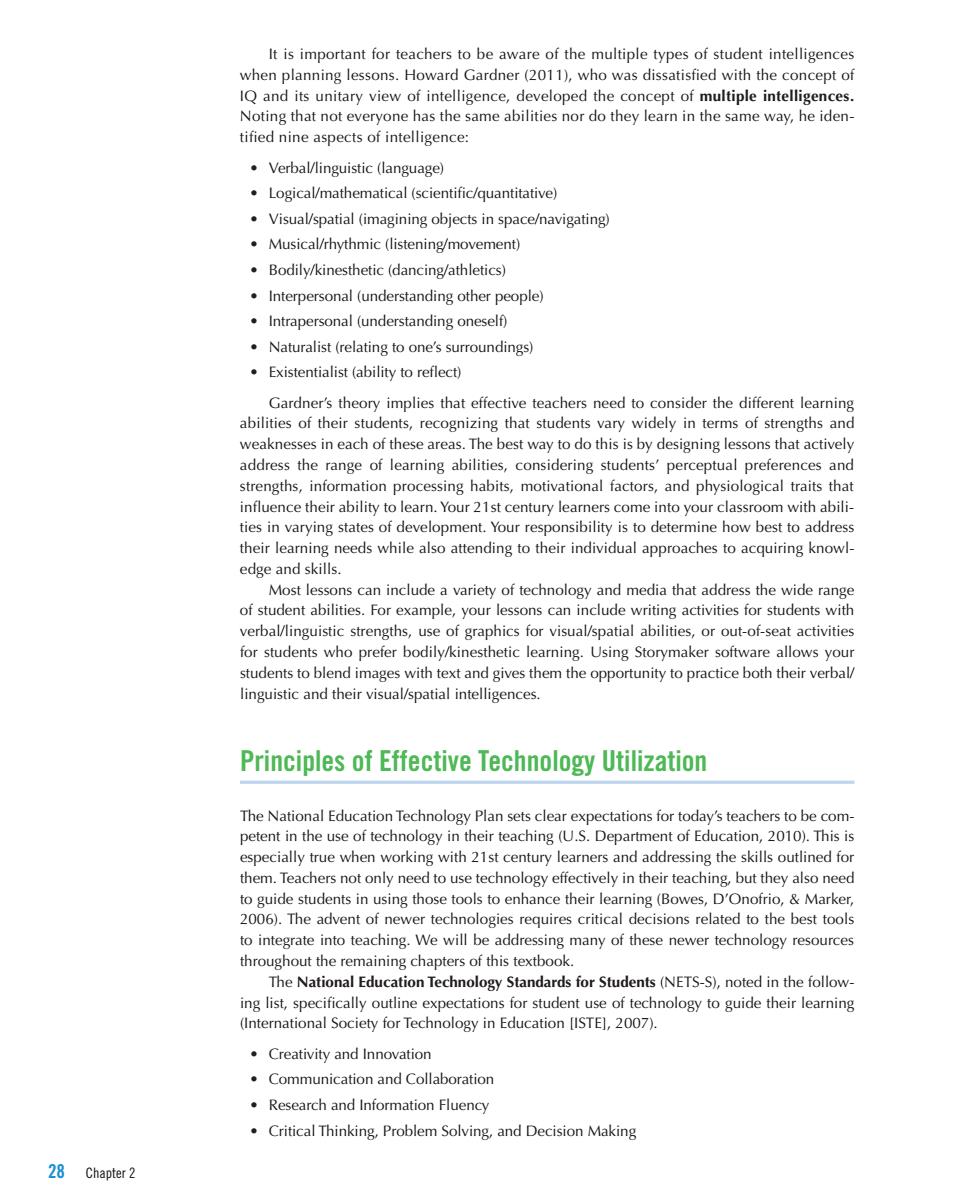正在加载图片...

g t is tant for teachers to be aware of the multiple types of student intelligence ssons.Ho Gardner (2011),wh was dissatisfie the concept o Q and its unitary view eveloped the fmultiple intellige enth ame abities nor do theyem in the ameyhed .Verbal/linguistic (language) Logical/mathematical (scientific/quantitative) .Visual/spatial (imagining objects in space/navigating) Musical/rhythmic (listening/movement) .Bodily/kinesthetic(dancing/athletics) Interpersonal (understanding other people .Intrapersonal (understanding oneself) Naturalist(relating to one's surroundings .Existentialist(ability to reflect) ows心 es of the ely in terms of strengths a of th ese areas. st way to do this is by de signing 5501 s that activel ering students perceptua preferences and strengths,information processing habits,motivational factors,and physiological traits tha influence their ability to learn.Your 21st century learners come into your classroom with abili ties in varying states of development.Your responsibility is to determine how best to addres their learning needs while also attending to their individual approaches to acquiring knowl edge and skills. Most lessons can include a variety of technology and media that address the wide range of student abilities.For example,your lessons can include writing activities for students with verballinguistic strengths,use of graphics for visual/spatial abilities,or out-of-seat activities for students who prefer bodily/kinesthetic learning.Using Storymaker software allows your students to blend images with text and gives them the opportunity to practice both their verbal/ linguistic and their visual/spatial intelligences. Principles of Effective Technology Utilization The National Education Technology Plan sets clear expectations for today's teachers to be com- petent in the use of technology in their teaching (U.S.Department of Education,2010).This is especially true when working with 21st century learners and addressing the skills outlined for them.Teachers not only need to use technology effectively in their teaching but they also need to guide students in using those tools to enhance their learning(Bowes,D'Onofrio,Marker, 2006).The advent of newer technologies requires critical decisions related to the best tools to integrate into teaching.We will be addressing many of these newer technology resources throughout the remaining chanters of this textbook The National Education Technology Standards for Students (NETS-S),noted in the follow- ing list,specifically outline expectations for student use of technology to guide their learning (ntemational Society for Technology in Education [STE,2007). Creativity and Innovation Communication and Collaboratior Research and Information Fluency Critical Thinking Problem Solving and Decision Making 28 Chapter 228 Chapter 2 It is important for teachers to be aware of the multiple types of student intelligences when planning lessons. Howard Gardner (2011), who was dissatisfied with the concept of IQ and its unitary view of intelligence, developed the concept of multiple intelligences. Noting that not everyone has the same abilities nor do they learn in the same way, he identified nine aspects of intelligence: • Verbal/linguistic (language) • Logical/mathematical (scientific/quantitative) • Visual/spatial (imagining objects in space/navigating) • Musical/rhythmic (listening/movement) • Bodily/kinesthetic (dancing/athletics) • Interpersonal (understanding other people) • Intrapersonal (understanding oneself) • Naturalist (relating to one’s surroundings) • Existentialist (ability to reflect) Gardner’s theory implies that effective teachers need to consider the different learning abilities of their students, recognizing that students vary widely in terms of strengths and weaknesses in each of these areas. The best way to do this is by designing lessons that actively address the range of learning abilities, considering students’ perceptual preferences and strengths, information processing habits, motivational factors, and physiological traits that influence their ability to learn. Your 21st century learners come into your classroom with abilities in varying states of development. Your responsibility is to determine how best to address their learning needs while also attending to their individual approaches to acquiring knowledge and skills. Most lessons can include a variety of technology and media that address the wide range of student abilities. For example, your lessons can include writing activities for students with verbal/linguistic strengths, use of graphics for visual/spatial abilities, or out-of-seat activities for students who prefer bodily/kinesthetic learning. Using Storymaker software allows your students to blend images with text and gives them the opportunity to practice both their verbal/ linguistic and their visual/spatial intelligences. Principles of Effective Technology Utilization The National Education Technology Plan sets clear expectations for today’s teachers to be competent in the use of technology in their teaching (U.S. Department of Education, 2010). This is especially true when working with 21st century learners and addressing the skills outlined for them. Teachers not only need to use technology effectively in their teaching, but they also need to guide students in using those tools to enhance their learning (Bowes, D’Onofrio, & Marker, 2006). The advent of newer technologies requires critical decisions related to the best tools to integrate into teaching. We will be addressing many of these newer technology resources throughout the remaining chapters of this textbook. The National Education Technology Standards for Students (NETS-S), noted in the following list, specifically outline expectations for student use of technology to guide their learning (International Society for Technology in Education [ISTE], 2007). • Creativity and Innovation • Communication and Collaboration • Research and Information Fluency • Critical Thinking, Problem Solving, and Decision Making M02_SMAL4150_01_SE_C02.indd 28 2/7/14 8:37 AM